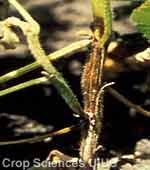Phytophthora Rot


Symptoms:
- Phytophthora can attack and rot seeds and seedling prior to or anytime after emergence.
- At the primary leaf stage, infected stems appear bruised and are soft, secondary roots are rotted, the leaves turn yellow, and plants frequently wilt and die.
- Pythium is a related pathogen that causes similar symptoms on seeds and seedlings.
- Older plants may die throughout the season.
- Dark brown lesions form on the roots, roots rot, and a distinct dark brown discoloration of the stem may extend from below the soil line upward into the branches.
- Leaves turn yellow, wilt, and stay attached after death of plants.
- In tolerant varieties, plants may be stunted but not killed.
- Symptoms on tolerant varieties may be restricted to rotting of lateral roots and browning of the tap root resulting in hidden damage that may reduce yields.
Pathogen Involved:
- Phytophthora sojae is a fungal-like pathogen that survives in soil for up to 5-10 years in association with decomposed soybean tissues.
- Soybean is the only known crop host for this pathogen.
- This pathogen infects soybean at all stages of development, and is most active and causes most damage in wet soils.
Time of Occurrence:
- All season.
Conditions Favoring Disease:
- The disease often occurs after wet weather and in low, poorly drained areas, particularly on clay, compacted soils.
Disease Management:
- Resistant varieties. Varieties with race-specific resistance should be used. Varieties that have high levels of tolerance to Phytophthora rot may reduce the seedling and adult phase of the disease.
- Fungicidal seed treatments can also reduce damage to seed and young seedlings.
- Soil drainage should be improved if possible, and low areas of fields should be avoided, especially if a field has a history of seedling or root rot problems.
- Crop rotation may be of some benefit.
For more information on Phytopthora rot, see Management of Phytophthora Root and Stem Rot of Soybeans.